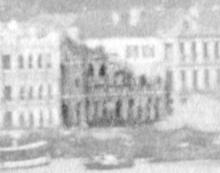Extract from Carl T. Smith's "Wanchai: In Search of an Identity", published in the book "Hong Kong. A Reader in Social History":
The Sisters of Charity of St Paul of Chartres owned the lots next to the Blue Buildings. On the seafront of the property they built European-style residences similar to the Blue Buildings and leased them in 1863 to Joao Joaquim Dos Remedios, a wealthy Portuguese merchant. He, in turn, subleased them to tenants.
In spite of the intrusion of Chinese shops, the quality of the neighbourhood, as far as the foreigners were concerned, was maintained by the convent, foundling home and associated institutions of the Sisters of St Paul on Marine Lots 23 and 24. The sisters arrived in Hong Kong in 1845, and Father Feliciani bought ML 23 for them. At the time it had 'two substantial English built houses' on it. The Crown Lessee of this lot was a contractor John Dalton Hawkins who had purchased it at a government land sale in 1844. In September 1845 he was imprisoned for debt and his Wanchai lot was bought by John Smith, a store-keeper, who sold it in December to Father Antonio Feliciani. The Father also bought the adjoining Lot 24 in 1848 for the Sisters as their work of caring for foundlings was expanding.
In 1915 the Sisters sold their property to the Hong Kong Land Company and moved to their present location at Causeway Bay. The Land Company redeveloped it with buildings for Chinese occupancy and opened up two streets in 1917. These were named after two taipans of Jardine, Matheson & Co., the Honourable David Landale (Director 1902 – 21) and the Honourable Charles Edward Anton (Director 1911 – 18).


Comments
"French Convent", or "Asile de Sainte Enfance" ?
Henry Ching asks:
I notice that you have referred to the French Convent in Wanchai. I always thought that the Wanchai institution was known as the Asile de Sainte Enfance. I may well be wrong – was it known also as the French Convent? I suppose it was, in effect, a convent.
Good question. I've noticed both names used, but haven't looked at it in detail.
To try and get a better idea I've skimmed through the Blue Books, decade at a time, looking for mentions of this in the "Education" chapter.
So the school was known as the "French Convent" school in the early 20th century, and before the move to Causeway Bay. I've seen this location marked "French Convent" on late-19thC. maps, and guess the school was here too, but am not 100% sure.
There was definitely an earlier school named Asile de la Ste. Enfance, also in Wanchai but further east at Spring Gardens.
Regards, David
The French Convent (Asilede la St.Enfance)
The French Convent (Asilede la St.Enfance) situated on the Praya to the Eastward having also an entrance in Queen's Road East, was founded in Paris prior to the French Revolution (in Hongkong in 1848), as "Les Surs de Charite de St. Paul de Chartres." It comprises day and boarding schools and its educational attainments are up to the requirements of the Government Education Department. It has also a native Orphanage and provides for the aged poor. Its means of support are obtained by the sale of needlework as also from the school fees and the Government-grant. It has in the Far East— 5 branch establishments in Japan, and 5 also in Tonquin. In Hongkong the number of its inmates is 350.
Source: The Tourist's Guide to Hong Kong, with short trips to the Mainland of China (1897) by HURLEY, R. C.
In the foundation of Catholic
In the foundation of Catholic Missions by Xia Qilong a detailed account is given of the dispute between the French and Italian Catholics over this site.
The St Paul Sisters first arrived on 12th September 1848 with Bishop Forcade. His initial dispute/falling out with the existing HK Catholic Authorities on Wellington Street spilled over into a 14 year fight over the control of this site, including three ecclesiastical interdicts against the sisters, which was finally settled by Rome in 1864. The bad blood lasted another generation with most of the sisters moving to Indochina. and the French sisters being refused permission to expand their presence in Hong Kong.
The first site for the asylum was a Matshed on the hill near St Francis Yard. The site was poor with a couple of the sisters and many of the foundlings dying, giving impetus for the move to the ML 23 & 24 site in 1851.
Site was sold in 1915 with Anton and Landale Street being laid down in 1917.
Between 1848 to 1894 the sisters baptized 30,871 infants, an average for 600 per year(alot in a predominately male migrant society). - essentially the Sisters were rescuing abandoned female children.
Source: The foundation of the Catholic mission in Hong Kong, 1841-1894 (Xia Qilong 1998 HKU)
One other point is that this is the second iteration of ML 23 & 24. The first such lots were in Admiralty but were quickly resumed for military use by the mid 1840's
Please add Marine Lot 23 and
Please add Marine Lot 23 and 24 (ML 23, ML 24) to Previous Places
& (1st Location to Title) Thank you.